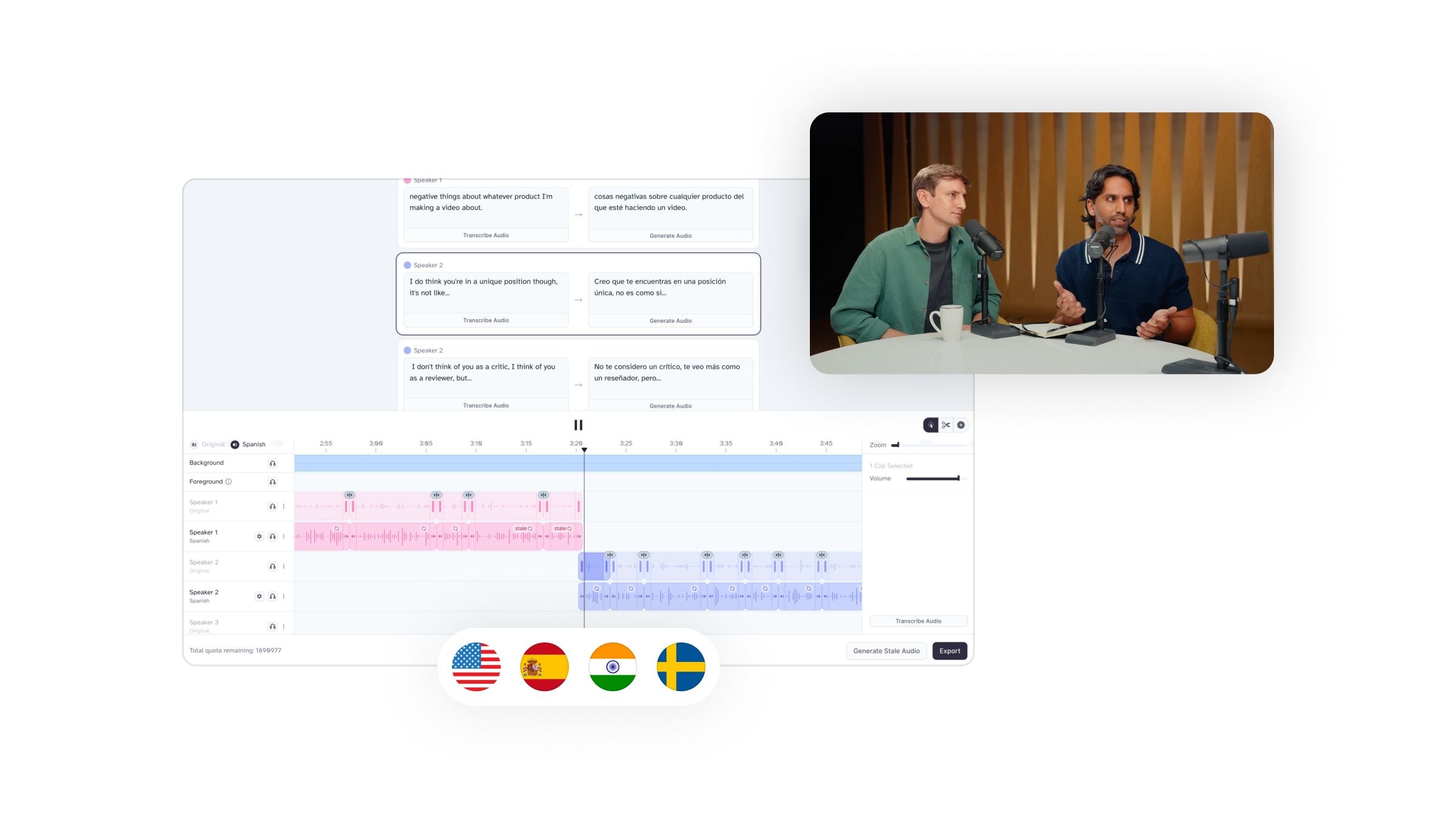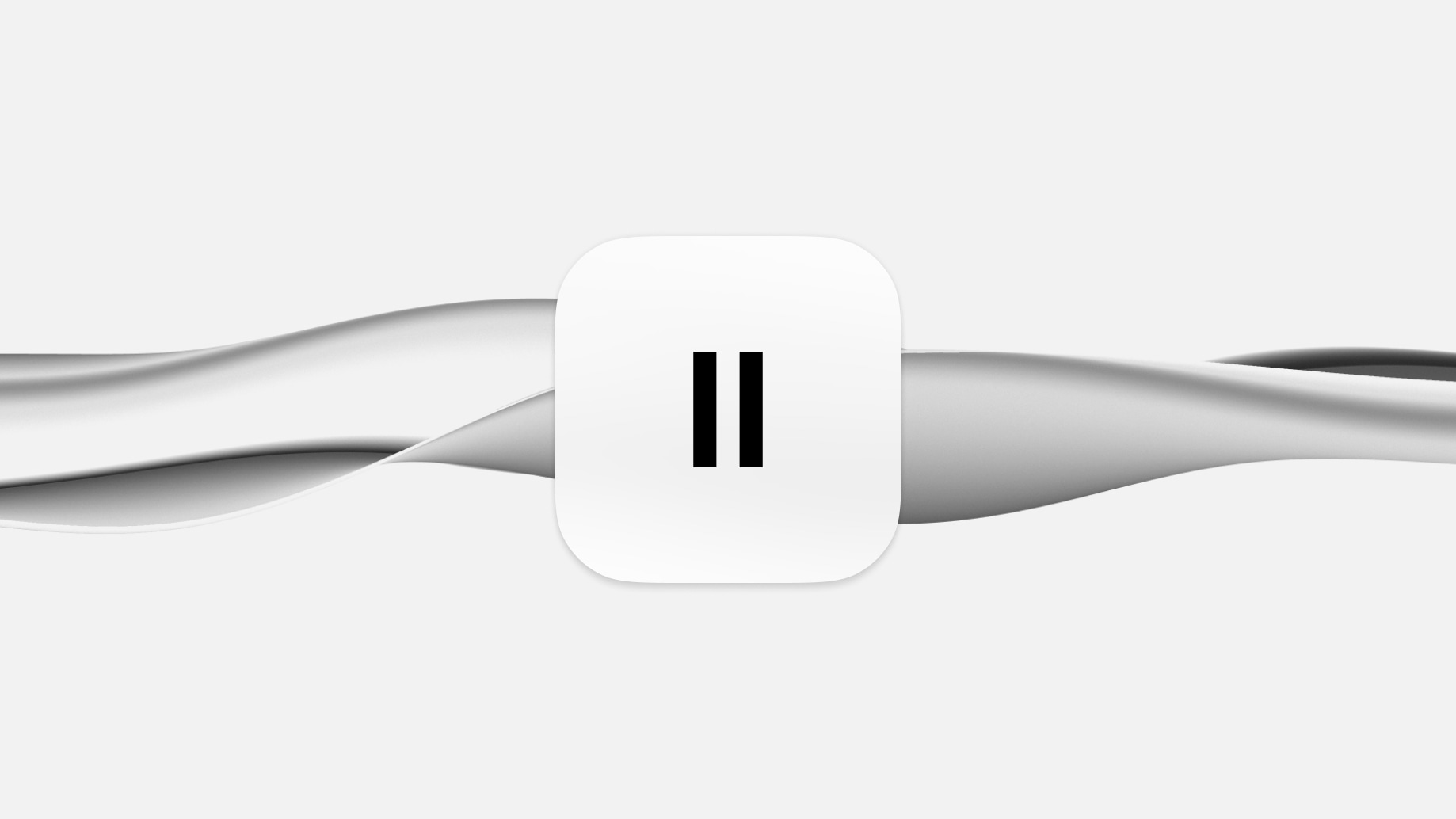
Traduza áudio e vídeo preservando a emoção, o timing, o tom e as características únicas de cada interlocutor
Apresentando o Eleven v3 (alpha)
Experimente o v3A tradução de vídeo e a dublagem com IA quebram barreiras linguísticas, tornando os vídeos compreensíveis em todo o mundo. Neste artigo, vamos explorar o que são e como funcionam.
Tradução de vídeo e dublagem com IA estão revolucionando o consumo de conteúdo. Elas permitem que vídeos sejam entendidos globalmente, transcendendo barreiras linguísticas. Essa tecnologia é crucial em um mundo onde vídeos facilmente cruzam fronteiras. Não se trata apenas de traduzir palavras—é sobre preservar o tom, a emoção e o contexto do vídeo original.
Quer começar agora mesmo? Experimente a ferramenta AI Dubbing & Video Translator da ElevenLabs.

Traduza áudio e vídeo preservando a emoção, o timing, o tom e as características únicas de cada interlocutor
Neste artigo, exploramos o que são a tradução de vídeo e a dublagem com IA, como funcionam e por que são vitais se você deseja se comunicar globalmente.
A tradução de vídeo e a dublagem com IA estão transformando como experimentamos conteúdo em diferentes idiomas. Ao contrário da dublagem tradicional, onde atores humanos regravam incansavelmente os diálogos, a dublagem com IA utiliza algoritmos sofisticados para replicação de voz e tradução de conteúdo.
Essa tecnologia não apenas traduz palavras, mas também captura o tom e a emoção do falante original, oferecendo uma experiência de visualização mais autêntica.
Redes neurais, um tipo de inteligência artificial que imita o funcionamento do cérebro humano, desempenham um papel fundamental na dublagem com IA. Essas redes analisam vastas quantidades de dados linguísticos, aprendendo nuances e expressões idiomáticas para garantir traduções precisas e culturalmente relevantes.
Além disso, a dublagem com IA se destaca pela eficiência. Ela reduz significativamente o tempo e os custos de produção, tornando-se uma opção viável para criadores de conteúdo que visam um público global. Isso é especialmente crítico em um cenário digital rico em conteúdo, onde a rapidez no mercado pode ser uma vantagem competitiva.
A tradução de vídeo e a dublagem com IA estão em constante evolução. Avanços contínuos em algoritmos de aprendizado de máquina significam que a IA pode se adaptar a diferentes dialetos e sotaques, aprimorando ainda mais a localização do conteúdo. Essa capacidade está revolucionando indústrias como cinema, televisão e educação online, onde conteúdo acessível e relacionável é fundamental.
Existem 3 etapas principais no processo de tradução de vídeo e dublagem com IA. São elas:
É aqui que tudo começa. A IA ouve o vídeo original e capta cada palavra falada. Não se trata apenas de captar palavras, no entanto. A IA deve entender as diferentes formas de falar das pessoas, como vários sotaques ou dialetos. Isso garante que tudo o que é dito no vídeo seja reconhecido com precisão antes de traduzir.
Agora é hora de traduzir. A IA considera o contexto—a situação ou o tópico da conversa—e as nuances culturais. Isso significa que ela presta atenção em como as coisas são ditas em diferentes culturas para manter a tradução precisa e significativa. É crucial que piadas, expressões idiomáticas e ditados façam sentido no novo idioma.
A etapa final é dar voz ao texto traduzido. A IA usa a tecnologia text-to-speech para criar uma voz que soe natural e combine com o estilo do falante original. O objetivo é fazer com que a versão dublada pareça tão real e autêntica quanto a original.
Por trás de todo esse processo está o aprendizado de máquina, um tipo de IA que fica mais inteligente com o tempo. Ao aprender com cada tradução, a IA se torna mais precisa e melhor em lidar com tarefas linguísticas complexas.
Utilizar ferramentas de tradução de vídeo e dublagem com IA oferece aos criadores vários benefícios importantes, especialmente em comparação com métodos tradicionais de tradução/dublagem.
Uma das maiores vantagens da tradução de vídeo e da dublagem com IA é tornar o conteúdo acessível para pessoas em todo o mundo. Imagine um programa de TV popular ou um vídeo educacional. Originalmente, está em um idioma, talvez inglês. Mas com a dublagem com IA, espectadores de diferentes países podem assisti-lo em seu idioma. Isso quebra barreiras linguísticas, permitindo que mais pessoas aproveitem e aprendam com o conteúdo, não importa onde estejam.
Tradicionalmente, dublar um vídeo em outro idioma era caro. Envolvia contratar dubladores, equipamentos de gravação e muito tempo. A dublagem com IA muda isso. É uma opção mais acessível porque usa tecnologia, não pessoas, para traduzir e dublar. Isso significa que as empresas podem economizar dinheiro enquanto ainda fornecem conteúdo de qualidade em vários idiomas.
A dublagem com IA é muito mais rápida do que a dublagem tradicional. O método antigo significava gravar cada linha de diálogo, o que leva muito tempo. Com a IA, a tradução e a dublagem acontecem quase instantaneamente. Essa rapidez significa que as empresas podem produzir e lançar conteúdo em vários idiomas muito mais rápido. Para indústrias como notícias ou entretenimento, onde o tempo é crucial, isso é um benefício significativo.
Quando o conteúdo é traduzido e dublado de forma tradicional, às vezes o sentimento ou emoção original se perde. A tecnologia de dublagem com IA visa manter o tom e a emoção original do falante. Isso é importante porque ajuda o público a se conectar com o conteúdo em um nível mais profundo, assim como o público original fez.
Descubra como a tradução de vídeo e a dublagem com IA estão revolucionando várias indústrias. Do entretenimento à educação e negócios, essas tecnologias estão quebrando barreiras linguísticas e abrindo novas possibilidades.

No mundo dos filmes, programas de TV e conteúdo online, a tradução de vídeo e a dublagem com IA desempenham um papel enorme. Imagine assistir a um filme estrangeiro em seu próprio idioma sem perder a sensação original das vozes dos personagens. É isso que a dublagem com IA faz. Ela permite que pessoas de diferentes partes do mundo aproveitem o conteúdo em seu idioma, ampliando o público para cineastas e criadores de conteúdo.
Educação é sobre acessibilidade. Com a dublagem com IA, materiais educacionais como palestras, documentários e cursos online podem alcançar estudantes globalmente, independentemente das barreiras linguísticas. Isso é especialmente importante para plataformas de e-learning, onde o conteúdo precisa ser compreensível para alunos de várias origens linguísticas. A dublagem com IA ajuda a quebrar essas barreiras linguísticas, tornando a educação mais inclusiva.
Para empresas que operam internacionalmente, a comunicação é fundamental. A dublagem com IA entra em cena em vídeos de marketing e materiais de treinamento. Ao traduzir e dublar conteúdo promocional e de treinamento, as empresas podem alcançar um público mais amplo e garantir que seus funcionários em todo o mundo recebam a mesma qualidade de treinamento. Essa uniformidade é crucial para manter os padrões da empresa em todo o mundo.

A ElevenLabs oferece uma ferramenta que permite a tradução de conteúdo em 29 idiomas rapidamente, com recursos como tradução de voz, detecção de falantes e dublagem de áudio. Você pode fazer upload de várias fontes como YouTube, TikTok ou até mesmo diretamente via URL. A ferramenta mantém o estilo de voz original e lida eficientemente com múltiplos falantes.

A Rask AI se especializa em criar transcrições, traduções e locuções com recursos únicos como clonagem de voz e sincronização labial (atualmente em Beta). Ela suporta tradução de quase qualquer idioma para mais de 130 idiomas, tornando-a versátil para uma variedade de projetos.
.webp&w=3840&q=95)
A Dubdub.ai oferece dublagem com IA em mais de 40 idiomas globais. É adaptada para uma variedade de tipos de conteúdo, incluindo vídeos educacionais e documentários. A plataforma promete tempos de resposta rápidos, fácil colaboração e traduções sensíveis ao contexto para uma melhor experiência de dublagem.
Cada uma dessas ferramentas oferece recursos e capacidades únicas, tornando-as adequadas para uma variedade de necessidades de tradução de vídeo e dublagem com IA. Ao escolher uma plataforma, considere fatores como suporte de idiomas, facilidade de uso e recursos específicos que se alinham com os requisitos do seu projeto.
A tradução de vídeo e a dublagem com IA são tecnologias inovadoras que estão mudando a forma como compartilhamos e consumimos conteúdo globalmente. Elas quebram barreiras linguísticas, tornando os vídeos acessíveis a um público diversificado.
A dublagem com IA, especialmente, preserva a emoção e o estilo original, oferecendo uma experiência mais autêntica. Ferramentas como a ElevenLabs desempenham um papel crucial nessa transformação, oferecendo dublagem eficiente e precisa em vários idiomas.
Essas inovações não são apenas sobre entender diferentes idiomas—são sobre conectar pessoas e culturas. Interessado em experimentar essa tecnologia em primeira mão? Experimente a ferramenta de tradução de voz e dublagem com IA da ElevenLabs e veja como ela pode transformar seu conteúdo.

Traduza áudio e vídeo preservando a emoção, o timing, o tom e as características únicas de cada interlocutor

Localize vídeos com controle preciso sobre transcrição, tradução, tempo e mais

Dublagem e tradução de voz por IA estão mudando o jogo